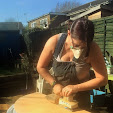Today Jessie and I attended the final session of her puppy obedience training programme. She has been passed worthy of joining the adult dogs from next week. There remain a few issues that we struggle with and, on the advice of the animal behaviourist who assessed her progress today, we have decided to try crate training.
Until quite recently, if I had seen a dog in a wire cage, I would have thought the owners very cruel indeed. So learning about this training approach has been something of a challenge for me. I have decided that I am willing to give it a go, as long as I am not ever expected to inflict on her any treatment that she finds traumatic.
All sources emphasise that the crate is never used for punishment, but that the dog should see it as a safe place where it can retreat to. There should always be a comfy mattress, water and a treat or activity in the crate for the dog. Some recommend covering the crate with a blanket to make it seem even cosier. Most wild canine species seek a den for sleeping, and the crate represents an equivalent of this. I never thought of it this way before.
Until the dog is happy to enter the crate, and regards it as a safe space, the door to the crate should be left open.
The crate should never be used as a long term confining space for the duration of (for example) an owner's working day.
Crate training can be used as an aid in toilet training. Dogs do not usually toilet in their own sleeping space. Placing their bed inside a crate will mean that the dog will wait until released before toileting, giving the owner greater control over this aspect. However, if the dog is confined to the crate for such a long period of time that it is forced to toilet inside the crate, this will set back the toilet training by several months.
All sources seem to recommend not giving the dog free run of the house until it is properly toilet trained. Before then, the dog should only be allowed the run of the house for short periods when you know that both its bladder and its bowel are empty.
Once a dog has been crate trained, transporting can be done by means of the crate. In our case, since Jessie is a large dog, transporting her crate will present a logistical challenge not presented by transporting her uncrated, so we probably won't use the crate as a means of transport.
Since she is nervous of things like buses and compressors coming close, I suspect she may prove to be afraid of fireworks. Come 5 November, I suspect her crate will prove a safe haven for her to retreat to.
Assuming, of course, that the whole exercise proves successful!
Monday, March 23, 2009
LPoD - crate training
Subscribe to:
Post Comments (Atom)


No comments:
Post a Comment